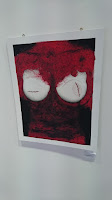People’s History Museum launched their incredible
exhibition Never Going Underground celebrating 50 years of the end to the
Sexual Offensives Act. It's open until September so go check it out!
(Lord Mayor Carl Austin-Behan and his husband Simon Austin-Behan)
(Lord Mayor Carl Austin-Behan and his husband Simon Austin-Behan)
There is so much to see and enjoy with this exhibition and
it’s a testament to the curating of staff and community involvement that have created a
range of voices and content revealing so much of our important history.
The most poignant piece in the exhibition for me was seeing
the above poster Lesbian and Gays Support the Miner’s poster art for 1985 Pride March
event in Hyde park. Not just because of the recent pride march but because on
the poster it states '16 not 21'. This made me really emotional because I was
born in 1985 and made me remember the entire length of my childhood other people we're campaigning for my rights.
Before I went to college I came out (feeling particularly
sexually curious having just come out) I was relieved to hear that they had
just lowered the age of consent to 16 making it acceptable by law to start
having sex with other men. It’s kind of crazy to think that they were campaign
before I was born and not changed until 2000 when they successfully able to
reduce the age of consent for same-sex relations between men to the Sexual
Offences (Amendment Act (2000).
I
literally grew up through all those campaigns and changes and was allowed to
join in with my friend on our first sexual conquests.
Here is a few snaps when I went around the exhibition. There
are fun interactive elements like adding suggestions to their Spotify list of
LGBT related tunes and game of frustration which relates to the experiences and
challenges of sexual and gender identity. They also give you the opportunity to
create your own t-shirt as I modeled- (ta-dah!).
I loved the sheer range of poster art peppered with video of
individual accounts of people personal history.
The launch event was so impressive. I was told that over 600 people had accepted the RSVP it certainly felt like there was more. It was really fun to see a lot of active LGBT representatives all under one roof. It was introduced by the Chair of People's History Museum Baroness Jan Royalland opened by Sir Ian McKellen.
He was very inspiring to listen to you can watch a slice here. Apologies for shaky, wobbly quality! I had a few drinks and I was with some friends but at least you get some of the raw footage. What was particularly striking to hear was the current figures of homeless LGBT people. McKellen said 150 young people were recorded in Manchester last year which sounds incredibly high.
He was very inspiring to listen to you can watch a slice here. Apologies for shaky, wobbly quality! I had a few drinks and I was with some friends but at least you get some of the raw footage. What was particularly striking to hear was the current figures of homeless LGBT people. McKellen said 150 young people were recorded in Manchester last year which sounds incredibly high.
It was all finished off my some glorious songs provided by Manchester Lesbian and Gay Chorus here is another little slice with Something Inside So Strong.
The exhibition is also complemented by Paralle Republic: The
Art of Civil Disobedience which is an exhibition of Syrian art and citizen
journalism. Conscientious artistic creation is a danger our act in Syria. When,
in 2011 , a group of school children were arrested and tortured for writing “Ash-sha’b
yurid isquat an-nizam” (“The people want to overthrow the regime”) on the walls Of Dera’a.
The act sparked renewed Syrian
protest and uprising at the Arab spring. As the war rages on and under the
weight of this oppression, countless artists, musician and activists were
standing up to be seen and heard, dealing with the chaos of war through
painting, illustration, photography, film, graffiti and music. The exhibition
was curated by Sarah Faraday and Ibrahim Fakhri and eveloped from an exhibition
which took place at Fuse Art Space (Bradford) in 2014, and also gratefully
acknowledges and builds on the work carried out through the exhibition “Culture
in Defiance”, held at Rich Mix in London and the Prince Claus Fund Gallery in
Amsterdam, (with thanks to Malu Halasa and Zaher Omareen.)
I particularly loved Khalil Younes who created
a series Revolution 2011 using pen and ink portraits of famous martyrs from
the a voice anymore because they were
killed, jailed or have fled uprising.
The work is supposed to ‘articulate the
emotions of those who don’t have a voice because they were killed, jailed or
have fled the country’. The work has totally inspired me and I definitely will
be influenced by this work in future images that I make!
I also really enjoyed spending time looking at this piece by
the collective Alshaab Alsori Aref Tarekh.
The collective was created by a fine art student from
Damascus University and a young calligrapher from the countryside outside of
Hama who made posters for the Arab Spring in Tunisia and Egypt when
demonstrations began in their home country of Syria. They were soon joined by
other Syrian artists and are now the anonymous fifteen member-strong poster
collective known as Alshaab Alsori Aref Tarekh (‘The Syrian People Know Their
Way’).


















No comments:
Post a Comment